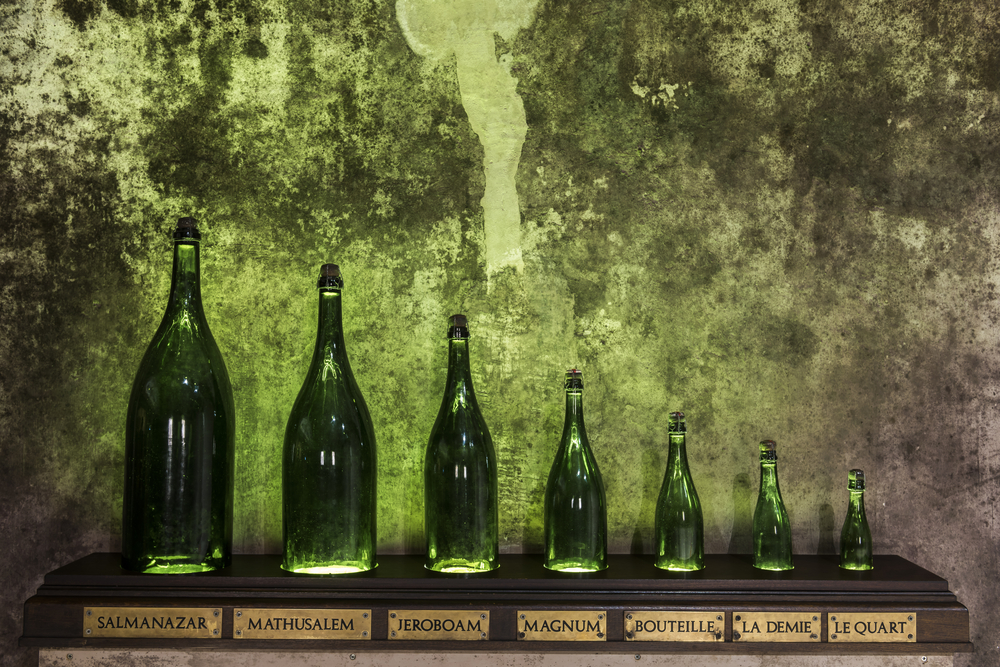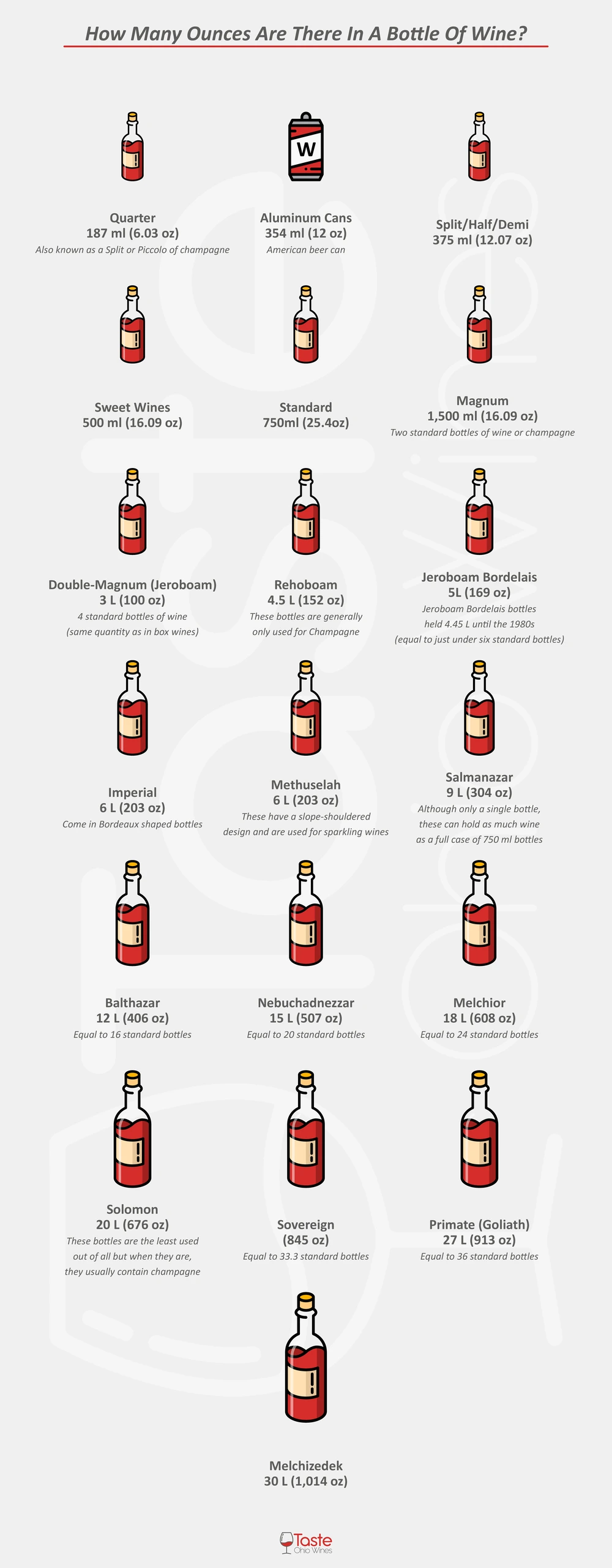You can choose from a whole myriad of wines. They differ in tastes and are available in all colors of the rainbow. However, one thing all typically sized bottles have in common is how many ounces are in the bottle.
Millimeters are the measure for beverage alcohol on all wine labels. When we consider the standard 750 ml bottle of wine, this translates to 25.4 ounces. For those of you who use non-metric measurements, this equates to slightly over 1.5 pints or just above ¾ of a quart.

Although most wine bottles come in 750 ml measurements, a lot goes into good quality production. But, knowing how many ounces are in a bottle can make it easier when understanding how much you can serve out at social gatherings and other events.
In today’s article, we will be discussing the different sizes of wine bottles available on the market. We will discover how much wine is held in these bottles and what types of wine bottles there are.
So, if you’re in the mood to find out more about wine bottle measurements, let’s continue.
Sizes Of Wine Bottles
The sizes of wine bottles were not always so uniform. However, the average sizes throughout history correlate with the size the average glassblower could blow.
It seems that there was a shift to using glass bottles during the 17th century. However, there is evidence that glass was being used for wine bottles as early as the Roman era.
Over the hundreds, if not thousands of years, while we have been using glass bottles, their sizes have varied. One thing remains though and that is we still love to use larger bottles when pouring wine.
Large bottles are extremely popular in many restaurants around the world, even when serving wines in glasses. The early days of wine drinking saw the Romans move from heavy, two-handled amphoras (large clay vessels) to more elegant glass bottles.
While those amphoras were a little impractical when pouring wine, they did hold an excessive amount of liquid.
According to The Oxford Companion of Wine, Roman amphoras could hold 26.14 gallons of wine (one cubic Roman foot) and the wine alone could weigh up to 218.5 pounds. That’s a lot of wine!
Types Of Wine Bottles

Share this Image On Your Site
As we mentioned, most wine bottles come in a standard 750 ml form. Nevertheless, various wine bottles come in different sizes. These depend on the brand and type of wine, however.
Below is a list of wine bottles you will usually come across when prowling for wine:
- Quarter – 187 ml (6.03 oz) These are also known as a Split or Piccolo of champagne
- Aluminum cans – 354 ml (12 oz) These are the same size as your average American beer can
- split/Half/Demi – 375 ml (12.07 oz)
- Sweet Wines – 500 ml (16.09 oz) These are a little lower in volume than standard bottles
- Magnum – 1,500 ml (16.09 oz) This is equal to two standard bottles of wine or champagne
- Double-Magnum (Jeroboam) – 3 L (100 oz) Equates to 4 standard bottles of wine which is the same quantity as in box wines
- Rehoboam – 4.5 L (152 oz) These bottles are generally only used for Champagne
- Jeroboam Bordelais – 5L (169 oz) – Jeroboam Bordelais bottles held 4.45 L until the 1980s (equal to just under six standard bottles)
- Imperial – 6 L (203 oz) – Come in Bordeaux shaped bottles
- Methuselah – 6 L (203 oz) – These have a slope-shouldered design and are used for sparkling wines
- Salmanazar – 9 L (304 oz) – Although only a single bottle, these can hold as much wine as a full case of 750 ml bottles
- Balthazar – 12 L (406 oz) – Equal to 16 standard bottles
- Nebuchadnezzar – 15 L (507 oz) – Equal to 20 standard bottles
- Melchior – 18 L (608 oz) – Equal to 24 standard bottles
- Solomon – 20 L (676 oz) – These bottles are the least used out of all but when they are, they usually contain champagne
- Sovereign – 25 L (845 oz) – Equal to 33.3 standard bottles
- Primate (Goliath) – 27 L (913 oz) – Equal to 36 standard bottles
- Melchizedek – 30 L (1,014 oz)
As you can see, wine bottles vary dramatically in size. The largest bottles such as the Melchizedek and Solomon are rarely used but are available for steep prices in some restaurants or wineries.
Wine Bottle Weights
In general, a full bottle of wine will weigh around 2.65 pounds. By learning about the weight of the wine grapes used in the bottle, you could get a more accurate reading.
In the uniform 750 ml wine bottle, you would find approximately 1.65 pounds of grapes in the wine. The average case will hold 12 bottles of wine which will weigh between 30 and 40 pounds.
However, it’s not just the wine that affects the weight of the bottles. Many wine manufacturers use different types of bottles for different brands. Therefore, some of the heaviest bottles are responsible for half of the weight including the wine.
Alternative Bottle Formats
The largest-sized wine bottles can be pretty tricky to come across. But, it’s not only these sizes that are quite unique. Below are some other distinctly odd bottle sizes to take into consideration too:
- 100 ml (3.3 oz) – Sometimes referred to as “test tubes”, these are sent by some wine clubs to trial the wine
- 310 ml (10.5 oz) – This is one quantity measurement of the classic French Jura Vin bottles
- 500 ml (16.9 oz) – This is considered to be the perfect size for a one-person dinner
- 620 ml (21 oz) – This is the second quantity measurement of the French Jura Vin bottle
- 1,000 ml (33.8 oz) – This is considered to be the perfect quantity for a two-person meal
As well as these, there is a more unique size of wine bottle. This comes in the form of 570 ml (20 oz) and was made especially for Sir Winston Churchill. The British Prime Minister during the Second World War considered this to be the perfect beverage serving for breakfast.
Want some perspective? When drinking juice in the morning, most of us will have just 6 to 8 ounces. Moving on!
Common Bottle Shapes
As well as varying sizes, wine bottles come in different shapes. One shape you are probably familiar with is the Burgundy bottle. This is typically used for Chardonnay, Rhone, Pinot Noir, and Syrah blends.
This bottle is also commonly used for the Spanish Tempranillo (a black grape variety of wine) but with a more elegant style.
Another shape you may recognize is the Alsace flute. This is most commonly used for wineries that make heavily scented white wine varieties. They are also used for dry and off-dry types of wine.
The Bordeaux bottle is perhaps the most common. Used for any other wines such as white and red varieties, this bottle is used to hold matured wines.
Other elegantly designed bottles hold the same amount of drink as these. One example is the Domaine Ott rose.
This variety of bottle hails from France and, despite its size and the fact that the weight for all standard-sized bottles remains the same, Domaine Ott rose bottles are easier to store due to their unique shape.
Do Wines Age Differently In Various-Sized Bottles?
In general, the larger the bottle, the slower the aging process will be. This happens because the ullage (amount of oxygen sealed in the bottle under the cork) is around the same, no matter the size of the bottle.
Therefore, the ullage of a larger bottle is spread over a larger amount of wine resulting in a slower aging process. Smaller bottles of wine will tend to age faster because of this.
However, this is not usually a concern as these sized bottles are typically consumed earlier to take advantage of their smaller volumes.
Can You Find Small And Large Wine Bottles Easily?
This depends on where you shop. When looking for premium quality wines, you will most often find magnums. As for other types of wines, you will usually find half bottles. Nonetheless, some wine producers like to make their wine in just one format.
Even if a wine producer bottles their wine in numerous formats, the larger bottles will usually be rarer. Such bottles tend to reach auction very quickly making them very hard to come by and purchase for yourself.
This is because larger-sized wine bottles are typically considered to be collectibles due to their rarity. Also, they usually age more gracefully making them an investment more than a quick drink option.
In Summary
The number of ounces in a wine bottle varies depending on the bottle size. However, the standard uniform bottle of wine will hold 25.4 ounces. Now you know how much a typical wine bottle holds, why not try another bottle format for a special occasion?
Larger bottles are generally preferred because they look more impressive and, of course, contain more wine for you and your friends. But, for a casual wine drinker, a regular-sized bottle is the best and cheapest option.
- Shrimp Cocktail (and More) Wine Pairing Guide - 09/06/2022
- What Wine Serving Sizes Look Like: Standard Size and More - 08/06/2022
- How Much Sugar is in Wine: Glass and Bottle Sugar Content - 08/06/2022






